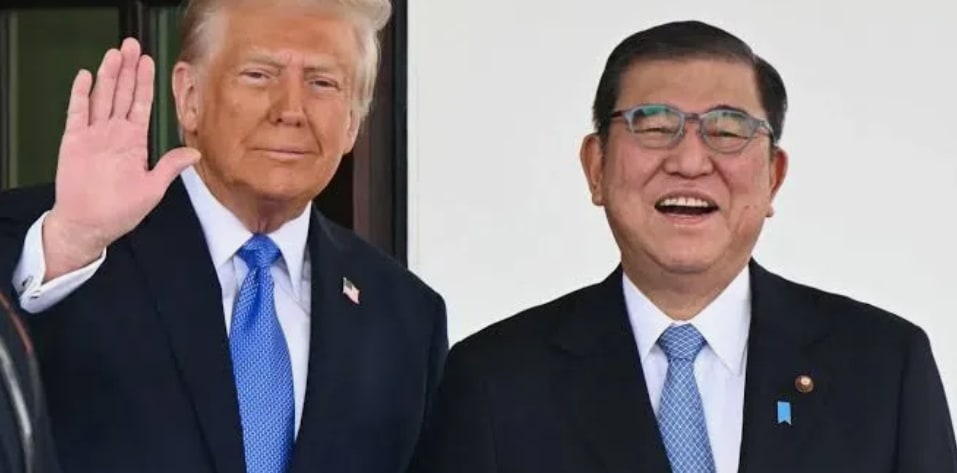**The US-Japan trade agreement grants Trump control over investments worth $550 billion. It Might Be “Vapor Ware” and Serve as an Example for Other Countries** Former President Donald Trump claimed in a high-profile announcement that a new US-Japan trade deal gave the United States leverage over 550 billion dollars in Japanese investment. The deal has been met with both enthusiasm and skepticism, with Trump hailing it as a landmark achievement for American manufacturing and job creation. Some have dubbed it potential “vapor ware” due to critics’ claims that the numbers may be exaggerated, the agreements are non-binding, and the economic impact is speculative. Nonetheless, the way the deal is structured and presented may be used as a model for US trade negotiations in the future, especially if the administration is focused on optics and unilateral gain. At the heart of the agreement is a framework wherein Japan pledged to direct investment toward American industries — especially manufacturing, infrastructure, and emerging technologies. During his presidency, Trump put bilateral trade agreements ahead of multilateral ones and hailed the agreement as an example of nationalist economics. It is in line with his “America First” platform, which places an emphasis on bringing manufacturing jobs back to the United States and reducing reliance on supply chains from other countries. However, experts caution that the headline figure of \$550 billion is misleading. Before the agreement was signed, a significant portion of the pledged investment was already in the works. Financial analysts point out that Japanese companies like Toyota, SoftBank, and Mitsubishi have been present in the United States for a considerable amount of time. Trump can take credit for the trade deal because it simply brings together anticipated and existing investments under a new political banner. Furthermore, the agreement lacks specific enforcement mechanisms. It does not include tariff adjustments, guarantees of market access, or procedures for resolving disputes like traditional trade pacts do. Instead, it resembles a memorandum of understanding, which is advantageous from a political standpoint but has no legal force. Because of this, some economists have referred to it as “vapor ware,” which refers to a policy that makes headlines but does not result in significant change. The deal’s strategy reflects a larger trend in the way trade agreements are being used as political capital, despite the ambiguity. By framing the deal as a huge economic win — regardless of its actual substance — Trump leveraged it for domestic approval and international prestige. His administration argued that the mere announcement of the deal created a “confidence effect,” encouraging private-sector investment and lifting stock markets.
For their part, Japanese officials saw the agreement as a way to keep good relations with each other while avoiding tariffs in response, especially on electronics and automobiles. As a result, Japan’s commitments are seen as more of a diplomatic offer than as economic adjustments. Tokyo has a long history of being cautious in trade negotiations, so it is unlikely that it has agreed to anything that would significantly harm its own industries. Other nations looking to maintain favorable ties with the United States without undergoing painful structural reforms might find this kind of symbolic trade agreement appealing. Bilateral “optics-based” agreements may be viewed as a more manageable alternative by nations wary of the complexities and political risks of multilateral deals like the Trans-Pacific Partnership. The strategy enables presidents in the United States to quickly highlight economic successes, despite the fact that the actual benefits could take years or never occur. That said, there are risks in over-relying on such models. If international partners begin to view these agreements as largely performative, U.S. credibility in trade negotiations could erode. If benefits that were promised, such as tax incentives, deregulation, or infrastructure upgrades, do not materialize, investors and businesses may also become disillusioned. The long-term success of such deals depends on follow-through, transparency, and measurable outcomes.
In conclusion, the US-Japan trade agreement serves as both a diplomatic and political instrument. While it may not fundamentally reshape economic relations between the two nations, it demonstrates how large-scale investment announcements can serve as political currency. Whether this model proves sustainable or merely symbolic will depend on its execution and the willingness of future administrations to bridge the gap between optics and outcomes. It is still a high-stakes mix of ambition, ambiguity, and image at the moment, reflecting the changing nature of trade diplomacy in the 21st century.

